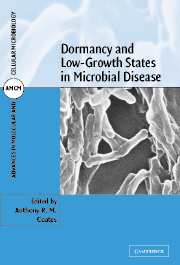Book contents
- Frontmatter
- Contents
- Contributors
- Preface
- 1 Physiological and molecular aspects of growth, non-growth, culturability and viability in bacteria
- 2 Survival of environmental and host-associated stress
- 3 Surviving the immune response: an immunologist's perspective
- 4 Quantitative and qualitative changes in bacterial activity controlled by interbacterial signalling
- 5 Mechanisms of stationary-phase mutagenesis in bacteria and their relevance to antibiotic resistance
- 6 Biofilms, dormancy and resistance
- 7 Tuberculosis
- 8 Gastritis and peptic ulceration
- 9 Resumption of yeast cell proliferation from stationary phase
- 10 Resting state in seeds of higher plants: dormancy, persistence and resilience to abiotic and biotic stresses
- Index
- Plate section
1 - Physiological and molecular aspects of growth, non-growth, culturability and viability in bacteria
Published online by Cambridge University Press: 18 August 2009
- Frontmatter
- Contents
- Contributors
- Preface
- 1 Physiological and molecular aspects of growth, non-growth, culturability and viability in bacteria
- 2 Survival of environmental and host-associated stress
- 3 Surviving the immune response: an immunologist's perspective
- 4 Quantitative and qualitative changes in bacterial activity controlled by interbacterial signalling
- 5 Mechanisms of stationary-phase mutagenesis in bacteria and their relevance to antibiotic resistance
- 6 Biofilms, dormancy and resistance
- 7 Tuberculosis
- 8 Gastritis and peptic ulceration
- 9 Resumption of yeast cell proliferation from stationary phase
- 10 Resting state in seeds of higher plants: dormancy, persistence and resilience to abiotic and biotic stresses
- Index
- Plate section
Summary
INTRODUCTION
Infection requires growth of pathogens in host tissues or on host epithelia. Cessation of growth is generally correlated with control of infection. Clinically latent infections may reflect microbial growth balanced by host control mechanisms such that the interaction remains below the threshold of detection. Alternatively, the pathogen may have genuinely ceased growth and survive in some form of stasis. In most cases we cannot distinguish between these possibilities. However, there have been important recent advances in our understanding of bacterial populations in which net growth cannot be detected and in recognising the limitations of in vitro culture as a means of determining the presence and viability of bacteria. These advances present new opportunities to study the role of non-growing and dormant bacteria in infection and to consider the degree to which culture-based methods may give a false impression of the absence of pathogens during infection, clinical latency and treatment.
The progress of molecular methods in microbiology challenges us to determine the molecular basis of growth and its regulation and to develop such methods to detect growth and viability. In the present context, the long term aim must be to recognise growth states of microbial populations in the human host.
BACTERIAL GROWTH
Growth involves the accumulation of biomass and may include genomic replication, cell division and an increase in the number of propagules of the organism concerned.
- Type
- Chapter
- Information
- Dormancy and Low Growth States in Microbial Disease , pp. 1 - 36Publisher: Cambridge University PressPrint publication year: 2003
- 3
- Cited by

